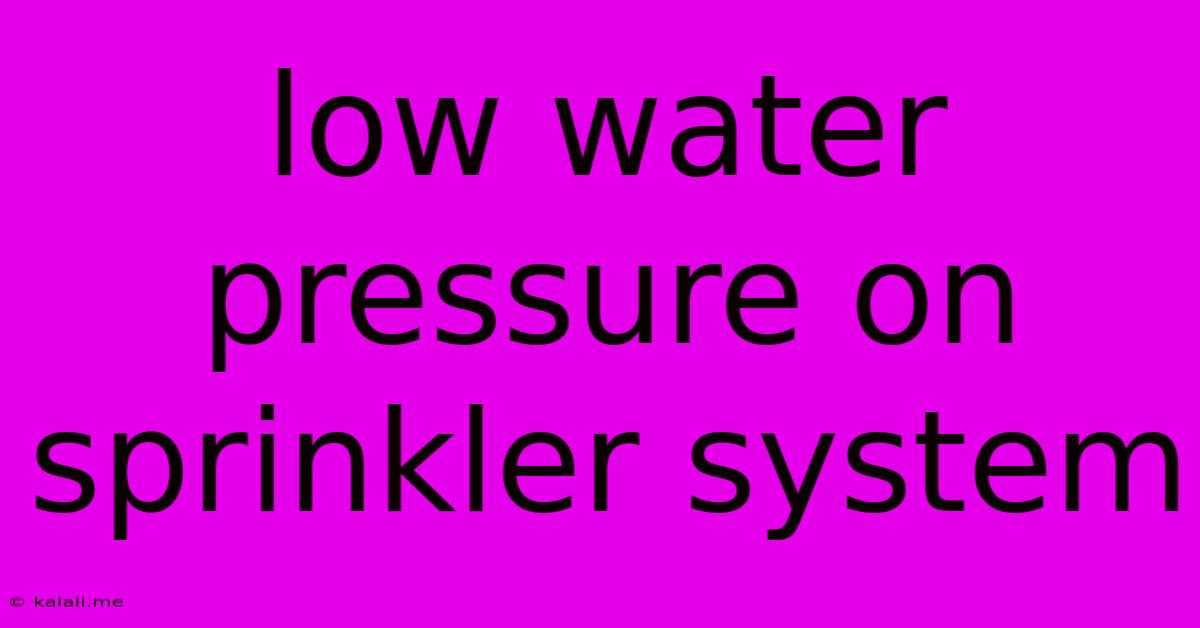Low Water Pressure On Sprinkler System
Kalali
Jun 05, 2025 · 4 min read

Table of Contents
Low Water Pressure in Your Sprinkler System: Troubleshooting and Solutions
Low water pressure in your sprinkler system is a frustrating problem that can leave your lawn parched and your plants struggling. This comprehensive guide will walk you through the common causes of low water pressure and provide practical solutions to get your sprinkler system back to peak performance. Understanding the root of the issue is key to effective troubleshooting, saving you time, money, and potential landscape damage.
Common Causes of Low Water Pressure in Sprinkler Systems
Several factors can contribute to reduced water pressure in your sprinkler system. Let's explore some of the most frequent culprits:
-
Low Municipal Water Pressure: This is often the first place to check. If your entire neighborhood experiences low water pressure, the issue lies outside your property and you should contact your local water utility company. They can provide information on scheduled maintenance or potential leaks affecting the entire water supply.
-
Clogged Sprinkler Heads: Over time, sprinkler heads can become clogged with debris like dirt, leaves, or mineral deposits. This restricts water flow, leading to reduced pressure. Regularly inspecting and cleaning your sprinkler heads is crucial preventative maintenance.
-
Leaking Pipes or Fittings: Leaks within your sprinkler system's piping network can significantly reduce water pressure. These leaks can be subtle, manifesting as damp patches of ground or consistently wet areas. A thorough inspection of all visible pipes and fittings is recommended.
-
Restricted Water Flow from Main Valve: The main valve controlling water flow to your sprinkler system can become obstructed. Sediment buildup or mechanical issues can impede the valve's ability to fully open, resulting in lower water pressure.
-
Kinks or Clogged Lines: Underground sprinkler lines can become kinked, damaged, or clogged with sediment. This restricts water flow and reduces pressure at the sprinkler heads. Locating and repairing these issues might require specialized tools or professional help.
-
Incorrect Valve Settings: Ensure that all valves in your sprinkler system are properly opened and functioning correctly. A partially closed valve will significantly impact water pressure.
-
Problems with the Backflow Preventer: A malfunctioning backflow preventer can restrict water flow. This device is essential for preventing contaminated water from flowing back into your municipal water supply. It should be inspected and serviced regularly by a qualified professional.
Troubleshooting Steps for Low Sprinkler System Pressure
Follow these steps to systematically diagnose the cause of low water pressure:
-
Check the Main Water Supply: Ensure that your main water valve is fully open and that there are no restrictions in the water supply line leading to your sprinkler system.
-
Inspect Sprinkler Heads: Carefully examine each sprinkler head for clogs. Remove any debris and ensure the head is free to rotate and spray water efficiently.
-
Check for Leaks: Look for any signs of leaks along the sprinkler lines, fittings, and valves. Listen carefully for unusual sounds that might indicate a leak. If a leak is suspected, it’s best to call a professional plumber.
-
Examine the Main Valve: Ensure that your main sprinkler valve is fully open and operating correctly. If it's difficult to turn, lubrication or professional servicing might be needed.
-
Test Water Pressure: Use a pressure gauge to measure the water pressure at various points in your sprinkler system. This can help pinpoint the location of the pressure drop.
-
Consider Professional Help: If you're unable to identify the cause of low water pressure after following these steps, it's advisable to contact a qualified irrigation professional. They possess the expertise and tools to diagnose and repair complex sprinkler system issues.
Maintaining Optimal Water Pressure
Preventing low water pressure involves proactive maintenance:
-
Regular Inspections: Inspect your entire sprinkler system at least twice a year, ideally before and after the peak irrigation season.
-
Cleaning Sprinkler Heads: Regularly clean sprinkler heads to remove debris and maintain optimal water flow.
-
Winterizing Your System: Properly winterize your sprinkler system to prevent damage from freezing temperatures.
-
Professional Maintenance: Consider scheduling annual professional maintenance to ensure your system is functioning efficiently and to identify potential problems before they become major issues.
By understanding the common causes and implementing the troubleshooting steps outlined above, you can effectively address low water pressure in your sprinkler system and keep your landscape thriving. Remember, timely intervention is crucial to prevent costly repairs and maintain the longevity of your sprinkler system.
Latest Posts
Latest Posts
-
How To Keep Glasses From Sliding Down My Nose
Jun 07, 2025
-
Fallout 4 How To Run Wire
Jun 07, 2025
-
Why Is My Cat Whining For Food So Much
Jun 07, 2025
-
Why Do Lots Of Companies Not Allow Prepaid Cards
Jun 07, 2025
-
Gimp Remove White Background To Transparent
Jun 07, 2025
Related Post
Thank you for visiting our website which covers about Low Water Pressure On Sprinkler System . We hope the information provided has been useful to you. Feel free to contact us if you have any questions or need further assistance. See you next time and don't miss to bookmark.